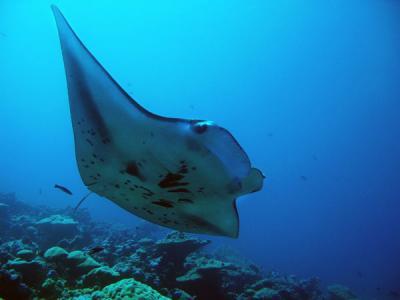We're open daily! View holiday hours
Science News
Land and Sea Connection
May 21, 2012

A recent paper, by Stanford researchers, highlights the remarkable interconnectedness between terrestrial and marine ecosystems. Published in the journal Scientific Reports, the paper describes the serendipitous discovery of interactions between birds and trees on a small Pacific island—and plankton and giant manta rays at sea.
Only 4.6 square miles in area, the Palmyra Atoll offers scientists the opportunity to compare largely intact ecosystems within shouting distance of recently disturbed habitats. A riot of life—huge grey reef sharks, rays, snapper and barracuda—plies the clear waters while seabirds flock from thousands of miles away to roost in the verdant forests of this tropical idyll.
This past fall, Stanford students Douglas McCauley and Paul DeSalles tracked manta rays’ movements around the atoll for a predator-prey interaction study. Swimming with the rays and charting their movements with acoustic tags, the scientists noticed the graceful creatures kept returning to the same particular coastlines. At the same time, Harvard’s Hillary Young was studying the coconut palm trees’ effects on bird communities and native habitats.
Over meals and sunset chats at the small research station, McCauley, DeSalles, Young, and other scientists discussed their work and traded theories about their observations. “As the frequencies of these different conversations mixed together, the picture of what was actually happening out there took form in front of us,” McCauley says.
The picture seems to look like this: seabirds prefer the native trees’ larger and more complex canopies to the human-planted coconut palms on the Palmyra Atoll. The birds feed on nitrogen-rich fish and squid and tend to leave their droppings, or guano, on the soil around those native trees. Rainfall washes these droppings into the nearby sea, enriching the phytoplankton (algae) in the water. The zooplankton (animals) feed on the enriched phytoplankton in these areas, attracting the giant manta rays.
Giant manta rays were abundant on the coasts where there were native trees nearby, but were not spotted at all where there were coconut palms.
This incredible food chain leads from sea to land to sea again. Carl Zimmer reports in Yale Environment 360 that:
The new study is a particularly striking illustration of a pattern that scientists are finding around the world. Life on land and life in the ocean are bonded in unexpectedly powerful ways. While they may seem like separate realms, the well being of one depends on the other.
(Zimmer offers more examples of this interdependence, as does the New York Times.)
The researchers also say that these findings shed light on how human disturbance of the natural world may lead to widespread, yet largely invisible, disruptions of ecological interaction chains. This, in turn, highlights the need to build non-traditional alliances—among marine biologists and foresters, for example—to address whole ecosystems across political boundaries.
“This is an incredible cascade,” says researcher Rodolfo Dirzo, of the Stanford Woods Institute for the Environment. “As an ecologist, I am worried about the extinction of ecological processes. This dramatically illustrates the significance of such extinctions.”
Image: Gareth Williams